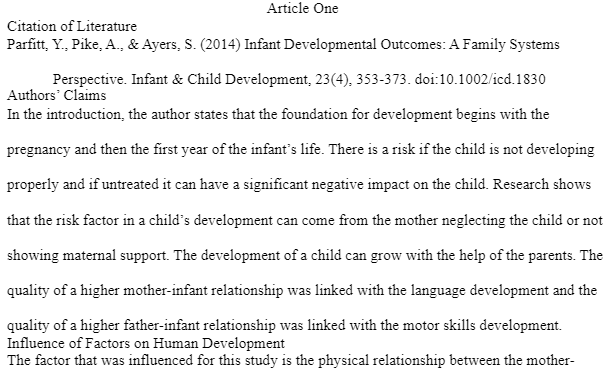PSY 211 Literature Worksheet -Snhu
$5.99
PSY 211 Literature Worksheet -Snhu
Article One Citation of Literature Parfitt, Y., Pike, A., & Ayers, S. (2014) Infant Developmental Outcomes: A Family Systems Perspective. Infant & Child Development, 23(4), 353-373. doi:10.1002/icd.1830Authors’ Claims In the introduction, the author states that the foundation for development begins with the pregnancy and then the first year of the infant’s life. There is a risk if the child is not developing properly and if untreated it can have a significant negative impact on the child. Research shows that the risk factor in a child’s development can come from the mother neglecting the child or not showing maternal support. The development of a child can grow with the help of the parents. The quality of a higher mother-infant relationship was linked with the language development and the quality of a higher father-infant relationship was linked with the motor skills development. Influence of Factors on Human Development The factor that was influenced for this study is the physical relationship between the mother-infant and the father-infant. Having a high quality of interaction with the infant made a positive impact on the infant’s motor skills and language development.
Description
PSY 211 Literature Worksheet -Snhu
Article One Citation of Literature Parfitt, Y., Pike, A., & Ayers, S. (2014) Infant Developmental Outcomes: A Family Systems Perspective. Infant & Child Development, 23(4), 353-373. doi:10.1002/icd.1830Authors’ Claims In the introduction, the author states that the foundation for development begins with the pregnancy and then the first year of the infant’s life. There is a risk if the child is not developing properly and if untreated it can have a significant negative impact on the child. Research shows that the risk factor in a child’s development can come from the mother neglecting the child or not showing maternal support. The development of a child can grow with the help of the parents. The quality of a higher mother-infant relationship was linked with the language development and the quality of a higher father-infant relationship was linked with the motor skills development. Influence of Factors on Human Development The factor that was influenced for this study is the physical relationship between the mother-infant and the father-infant. Having a high quality of interaction with the infant made a positive impact on the infant’s motor skills and language development.
PSY 211 Literature Worksheet -Snhu
This study did show that maternal postnatal post-traumatic stress disorder and depression lessened the development of language. If the child had a negative upbringing and wasn’t developed to their full potential can have significant negative impact on the individuals and have economic and social impacts on society as a whole. Historical Significance This article was based on a study, and anytime there is a study conducted it affects the historical evolution of developmental psychology. I strongly agree with the article findings, as it is vital for the development of an infant to be nurtured by both parents.
PSY 211 Literature Worksheet -Snhu


